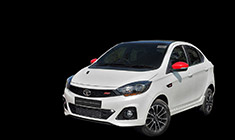News
2024 BYD eMax 7 : Observations after a day of driving
Getting up to 80 / 100 km/h is effortless and so is maintaining speed. Want to make a quick overtake? No worries there. Just bury the accelerator pedal and you will zoom past the vehicle ahead with ease.
Driving the BYD eMax 7
There are 2 battery options available in the BYD eMax 7 – a 55.4 kWh and a 71.8 kWh. The smaller battery pack is paired with a motor that makes 161 BHP, while the larger capacity battery pack gets the 201 BHP motor. Both, however, are Blade batteries which have cells that are made in a honeycomb-like structure. So, each cell serves as a structural beam to withstand force. Combined together and after placing high-strength panels on the upper and lower sides of the pack, the rigidity of the structure is increased.
Next up is the powertrain. Just like the Atto 3, the eMax 7 uses an 8-in-1 electric powertrain system. What does this mean? 8 components of the powertrain which are usually placed separately are combined into one component to optimize space and energy efficiency (also lesser cables). The components that are grouped in the powertrain are - VCU (vehicle control unit), BMS (battery management system), MCU (motor control unit), PDU (power distribution unit), DC-DC controller, on-board charger (explained earlier), drive motor and transmission.
We got to drive the 71.8 kWh battery pack with the 201 BHP motor. Start the car, shift to ‘D’ mode, take your foot off the brake pedal and the car gets off the line in the smoothest way possible. If you primarily drive around in the city, you will appreciate the smoothness of the motor. The power delivery till part throttle, is linear and predictable. No jerks from gearshifts and no engine sound means it is an extremely refined experience. Our preferred setting while driving in the city was Eco Mode as it felt adequate for keeping up with the traffic.
Floor the A pedal and you will be greeted with instant acceleration. The car is fast and the 310 Nm torque is available right from the get-go. BYD claims a 0-100 km/h time of 8.6 seconds and we don’t doubt it. You’ll definitely be ahead of most of the IC engine cars when the signal turns green and you will see some puzzled looks as to how this MPV is so quick off the line. The eMax 7 is very nimble on its feet and it doesn’t feel like a 7-seater MPV.
Out on the highway, the eMax 7 is just as good as in the city. Getting up to 80 / 100 km/h is effortless and so is maintaining speed. Want to make a quick overtake? No worries there. Just bury the accelerator pedal and you will zoom past the vehicle ahead with ease. You'll hit silly speeds effortlessly and not even realize it due to the lack of drama (engine noise, etc.). Remember that single-gear EVs don't have the higher-end punch above 120 km/h that geared turbo-petrol cars have. The top speed of the eMax 7 is limited to 180 km/h. If you drive hard, the range will drop faster.
There are 3 driving modes to choose from and these feel very gimmicky. There’s not much difference in these modes and apart from the throttle response, no other aspect changes.
• Normal Mode : This is the default mode to drive in and it works well in the city as well as on the highway. It is a good balance of power and economy.
• Eco Mode : When you want to extract maximum range, this is the mode to engage. The throttle response is dumbed down which results in a smoother drive. However, you never feel that the car is lacking power. There’s still enough power on tap to keep up with the traffic and make those quick overtakes. We found this mode to be the best for driving in the city.
• Sport Mode : The throttle response is sharp and the car feels ready to fly. Surprisingly, the power delivery is still linear in this mode. You won’t find this mode to be jerky and can even drive around smoothly. In fact, I realized that I was in Sport mode after almost half an hour of driving in bumper-to-bumper traffic.
Regenerative Braking
BYD has kept it simple with regenerative braking. There are only 2 levels – Standard and Larger (strange name). The Standard level is smooth and I preferred having the car in this mode. The Larger level very much resembles engine braking in IC engine cars. You do get a bit of a head nod when you get off the accelerator. It’s good for driving around in the city as well as on the highways.
Noise, Vibration & Harshness (NVH)
Without an engine or gearbox to make any noise, the overall driving experience is silent. At 100 km/h, the tyre noise is audible. We noticed something very strange about the wind noise. On the driver side, it is well controlled up to 100 km/h. On the passenger side, however, the wind noise starts creeping in at 80 km/h and at 100 km/h, it is considerably louder than the driver side.
Range
The BYD eMax 7 has an NEDC claimed range of 530 km. This test is done on a dynamometer and does not reflect the real-world range. In real-world driving conditions, you can expect a range of ~ 400-450 km. We’ll wait for some ownership reviews for a clearer picture of the car's real-world range.
Charging
With an 80 kW DC fast charger, the eMax 7 can be charged from 0% to 80% in 37 minutes. BYD has not shared the charging times using any other charger. If you ever run out of battery, you can always contact BYD’s roadside assistance.
Powering the BYD eMax 7 is a Permanent Magnet Synchronous Motor that puts out 201 BHP and 310 Nm. These are the same numbers as the BYD Atto 3:

You get hydraulic struts for the bonnet. There is also insulation on the underside:

Take a look at the underbody of the car from the back and you will spot this plate with battery details. Note that this is a 400V architecture:

Suspension
Ride Comfort
The eMax 7 gets a MacPherson strut suspension at the front and a multi-link suspension at the rear. BYD has managed to get the suspension tune to be comfortable at slow speeds. The ride quality is good in the city and the suspension feels absorbent. Small to medium-sized bumps are handled quite well and you won’t find many reasons to complain while driving in the city. There is a bit of side-to-side movement in the cabin over bad roads, but that is also primarily due to the car's shape. The suspension works silently, but big potholes do register themselves in the cabin with a loud thud. You have to be careful while tackling them. The recommended tyre pressure is 36 psi which is high. You can try and drop it to ~32 psi if you’re going to be driving primarily in the city. We would recommend topping it up to 36 psi when driving on the highway.
Handling & Dynamics
Inherently you don’t expect an MPV to handle like a hatchback. You have to be aware of the ~1,900 kg kerb weight of the car and it’s best to drive this MPV sedately. In a straight line, the eMax 7 feels stable till 120 km/h as long as the roads are smooth. You will notice a fair bit of vertical movement on the highway when going over small undulations or expansion joints on flyovers. There is body roll in corners and I found myself easing off the throttle just to avoid that uncomfortable feeling. There’s not much weight at the front end of the car which means that you don’t have enough confidence when turning into a corner. Best to drive this car sedately and enjoy the comfortable driving experience.
Steering
The electric power steering is very light and easy to operate. At city speeds, you will appreciate how easy it is to maneuver this MPV with its light steering. It weighs up when you get up to highway speeds, but not by much. A little more heft would’ve been nice for highway driving. It doesn’t feel very connected, so its not something enthusiasts will look forward to.
Braking
The eMax 7 gets ventilated discs at the front and solid discs at the rear. The stopping power is good and eMax 7 sheds speed effectively. There is some nose dive under heavy braking but its within expected levels. The brake pedal feels very linear which isn’t something we would expect in an electric car.
Continue reading the discussion on the BYD eMax 7 on our forum.

























